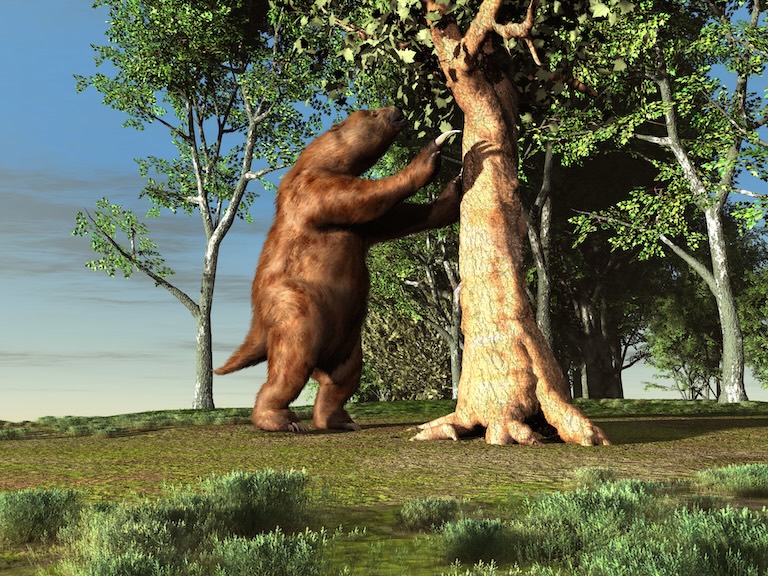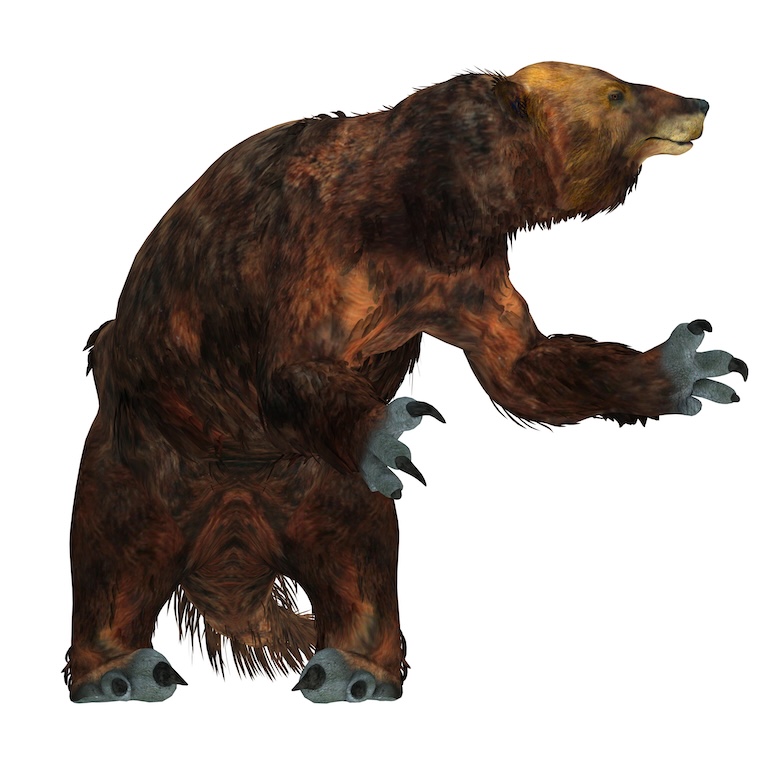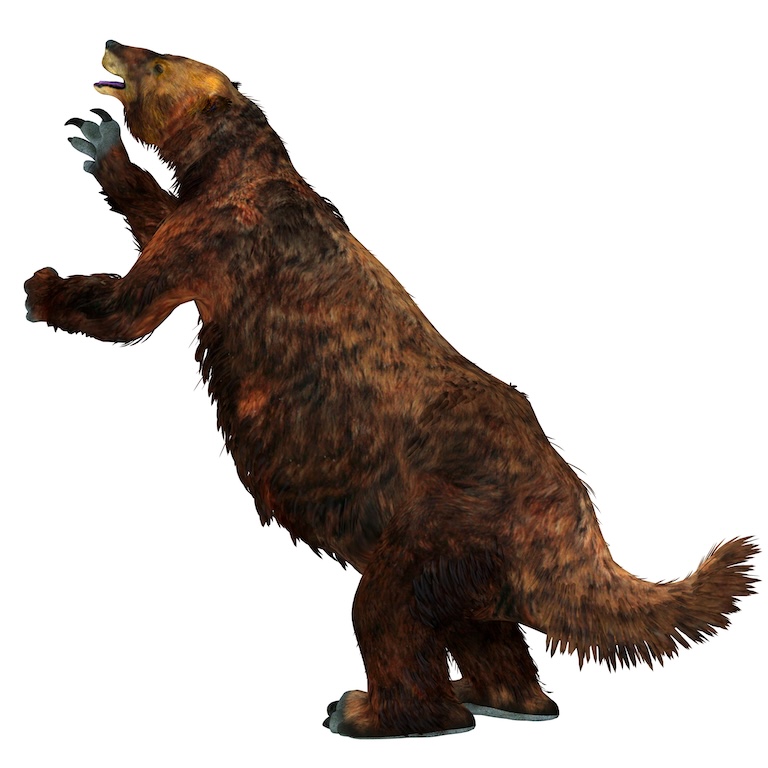Megatherium Profile
In the forests of South America, there are two genera of sloth. Both of which include small, bizarrely inverted individuals who move so slowly that moss grows on them.
On the other end of the spectrum, in the same location, there were once giant prehistoric sloths of epic proportions.
Some of these lived alongside humans in the early days, and one genus, Megatherium, had the largest of all.

Megatherium Facts Overview
| Habitat: | Woodland and grassland |
| Location: | South America, Except Brazil |
| Lifespan: | Unknown |
| Size: | 2.1m (6’ 11”) tall at the shoulder, 6m (20ft) long |
| Weight: | Up to four tons |
| Colour: | Unknown |
| Diet: | Thick grasses and leaves |
| Predators: | Humans, large cats, bears, wolves |
| Top Speed: | Unknown |
| No. of Species: | 8+ |
| Conservation Status: | Extinct |
This was a sloth the size of an elephant and would have been one of the largest animals on land at the time.
Far from being a slow creature, it was likely a very capable giant, able to feed at heights from the ground to four meters up.
They were heavily built and well-armed, but they likely spent most of their time chewing on foliage or resting to digest it.
Interesting Megatherium Facts
1. There were loads of them!
Megatherium is only one genus of ground sloth. There are thought to have been up to 80 of these so far discovered. Some were land-dwellers, and others were adapted better for marine life.
Megatherium is part of the Megatheriidae family and shares its record for the largest sloth with one other colossal example from the genus Eremotherium. These two are the closest relatives to modern 2 and 3-toed sloths, and within Megatherium alone there are at least eight described species.
This really goes to show the sheer diversity and abundance of animals that once roamed the planet.
The heaviest among them, and considered the type species, was appropriately named M. Americanum, which evolved to be larger and larger over the course of its existence as a species. 1
2. They had some serious thumbs
Like Iguanodon, the herbivorous dinosaur from the Jurassic, Megatherium had a formidable thumb spike.
This is likely to have served a similar purpose as a sharp, stabbing weapon to be used against predators or competition, and could possibly have played a role in sexual competition.
Two 4-ton giants wrestling with these in-built knives would have made a terrifying scene and may have given any natural predators a run for their money too.
A relative of Megatherium, the Megalonix genus of ground sloth, was named after this claw.

3. And they were strong!
There have been studies based on arm bones, that investigate the possible leverage an animal this size could get on an arm as long as it had. Shorter limb bones often suggest stronger animals as there are both leverage and stiffness bonuses to shorter bones that help with energy transfer.
The conclusion with Megatherium was that they might have been strong enough to flip over the car-sized [glyptodonts] that lived alongside them. This has led to some researchers hypothesising that Megatherium had a more diverse diet than just plants and leaves.
But their teeth are certainly not designed for eating meat, and no bone fragments of potential victims have been found inside their fossilised remains, either. While obligate herbivores generally wouldn’t turn down a hamburger if offered (even horses will eat meat), it’s still a bit of a long shot to suggest that the stabbing tools of this sloth were used for killing food.
It’s much more likely that this huge animal fed on plants, much in the way that the smaller, less frightening modern sloths do, and that any speed and strength perks for the sharp limbs were a defensive adaptation to the insane level of predators around at the time. 2
4. They had flexible hips
One of the ways we know that this animal could stand on its back legs and reach into the canopy is by the shape of its pelvis.
While a dog can stand on its hind legs if you really want to dance with it, this position puts a lot of strain on the hips as the girdle isn’t wide enough to naturally take this position.
In contrast, humans evolved to be upright, and have a pelvis well designed for that purpose. And ground sloths, while quadrupedal for the most part, had a wide pelvic girdle, which would have allowed them to stand up with relative ease. They’re also thought to have been able to walk around like this, making them the largest known bipedal animal.
They also had incredibly muscular tails, suggesting that they could use them much like a kangaroo does: as the third leg of a tripod. This would offer them a lot of support, and their enormous length could then be translated into canopy-reaching height, almost 4 meters up.
Those giant hooks and powerful arms could then help support their weight while they were up there. 3
5. They were faster than the current models
Very clever scientists looked into the ear bones of these giant sloths and picked out quite a few interesting discoveries.
The first is that the morphology is quite different than what we find in existing species that hang upside-down from trees and is actually more related to that of the armadillos and anteaters, whose subfamily sloths share.
From their discoveries, they conclude that the two genera of sloth that remain, while sharing very similar tree-hanging adaptations in their inner ears, evolved quite independently, which is a very impressive example of convergent evolution, in which similar environments favour identical adaptations.
But another thing they could imply from the shape of the inner ear is the level of agility in the animal. And the conclusion was that this enormous beast with its 4-meter erection and rapidly jabbing protrusions was of “medium agility”.
While they weren’t the fastest animal of the Pleistocene, Megatherium were nimble for their size, and a lot less lumbering than their tiny modern cousins.
6. Humans probably ate their brains
Nimble or not, they didn’t escape the axe – or in this case, the spear. Humans did what humans have always done, and destroyed their habitats and their families and ate a bunch of them until one day, there weren’t any left.
Of course, you’ll still find arguments about the ultimate cause of extinction, being that the climate was changing a lot at the time, too. And there may not be a single cause, but the pattern of megafaunal extinctions across the planet correlates exactly with the arrival of humans to those areas, so it’s not hard to spot the pattern.
Unlike some animals of the time, the fossil record shows clear human intervention here, with evidence of slaughter and butchery in many of the remains. One part of the animal may have been particularly valued.
Some remains have been seen which suggest there was something in the head worth getting at. Tool marks suggest the skull was opened up, perhaps to eat the brain of the sloth. If this happened to be a common practice, it might have meant that sloth brains were the stone-age delicacy that drove the genus to extinction. 4

Megatherium Fact-File Summary
Scientific Classification
| Kingdom: | Animalia |
| Phylum: | Chordata |
| Class: | Mammalia |
| Order: | Pilosa |
| Family: | Megatheridae |
| Genus: | Megatherium |
Fact Sources & References
- Pip Brewer (2018), “What was Megatherium?”, Natural History Museum.
- R. A. Fariña (1996), “Megatherium, the stabber”, Royal Society Publishing.
- Enrico de Lazaro (2021), “Paleontologists Find 3.58-Million-Year-Old Ground Sloth Fossil”, Sci News.
- Guillermo Abramson (2015), “On the roles of hunting and habitat size on the extinction of megafauna”, Science Direct.
